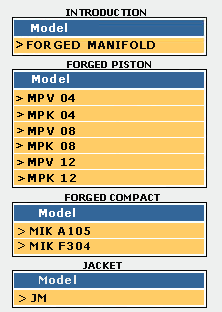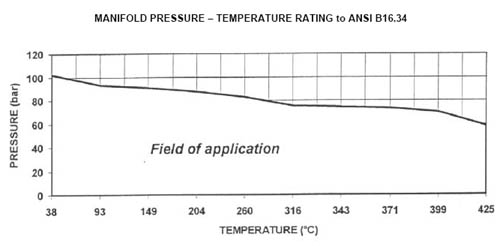 PAGE 1 2 3 4 5 6 7 8 9 |
|||||||||||||||
| STANDARD CONFIGURATION In this standard configuration, the MANIFOLD has: - Main connections : sizes 1½” SW ( according to ANSI B16.11 ). - Branch : size ½” or ¾” ( SW ANSI B16.11 or NPT ANSI B1.20.1 ) connections both for steam distribution and condensate collection. ( see fig. 4 ). Upon Customer request, the Manifold can be supplied with: - 1½” BW connections - ½” or ¾” BW connections The basic pattern has 4 valves ( MPV 04 ) ; Manifolds with 6 , 8 , 10 or 12 valves are obtained by welding together two or more basic patterns ( see data sheet enclosed ). The standard welds are SW type ; if welds are required to be X – RAYED , they can be BW. The Manifold can be supplied with a insulation jackets model " DOUGLAS JM " illustrated on data sheet N.9C241415 enclosed. The diagram below show the operating range of manifold with the max. Working pressure related to temperature. |
|||||||||||||||
 |
|||||||||||||||
| THE VALVE TRIMS The sealing system is made by a piston ( 4 ) in austenitic stainless steel that slider into two rings, one valve ring above ( 6 ) made in reinforced graphite, and one valve ring below ( 7 ) made in graphite interposed with thin stainless steel plates. The sealing surface is the surface of the piston. By tightening the bonnet nuts ( 9 ) that act on the spring washers ( 11 ), a constant load on the upper ring is obtained, securing the sealing toward the atmosphere. The same load, through the valve ring above ( 6 ) and the lantern ( 5 ), is applied to the lower ring that, by expanding itself the body ( 1 ) wall, and toward the surface of the piston when the valve is in closed position, ensures a perfect sealing of the valve against the flow of the fluid. Thanks to its very high resistance to the heat and to aggressive fluid, graphite has been selected as the primary component of the sealing rings. The valve ring below ( 7 ) is made by interposing sheets of graphite and thin stainless steel plates with the purpose to give mechanical strenght to the graphite, and to avoid that, when the valve is in open position, the graphite would collapse toward the empty space left by the piston. If this happens, the inner diameter of the lower ring will be reduced, seriously compromising the sealing of the valve. Further, the graphite has a lubricating effect of the piston surface. |
|||||||||||||||